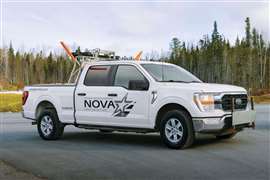Regional Report: Election hopes for the Indian market
14 April 2014

As well as having to contend with the monsoon season this summer, the Indian construction industry will face further disruption from the April – May general election. Following the March announcement of the election dates, the award of new contracts is on hold until the new parliament is in place, probably at the end of May.
This is a result of long-standing Election Commission rules that are designed to stop the incumbent party from influencing the electorate.
This means there is a ban on starting projects of any kind and a moratorium on awarding contracts on public infrastructure schemes such as roads and water networks.
The disruption is likely to last a good three months. With close to 815 million voters, India remains by far the world’s largest democracy and this number of people makes the logistics of an election formidable. This year the poll will be held in nine phases from April 7 to May 12, with results due to be announced on May 16.
Fresh blood
Although current Prime Minister Manmohan Singh has held the office for ten years, with a strengthened popular mandate in the 2009 election, his second term has been tarnished by corruption scandals around the sale of mobile telecoms licenses and the allocation of coal reserves, among others. These scandals caused a certain amount of paralysis in his coalition administration, and the construction industry has undoubtedly felt a slowdown.
Mr Singh, now aged 81, has always said he would step down after his second term in office, so whatever the outcome of this year’s election, there will be a new figure leading India in a few weeks. Many hope a new personality and an injection of new ideas will provide fresh impetus for the construction industry.
In terms of personalities, the two heavyweights are Rahul Gandhi of the incumbent Indian National Congress (INC), and Narendra Modi, prime ministerial candidate of the Bharatiya Janata Party (BJP). Things are a little confused in that Mr Ghandi is named as the head of the campaign, with the INC yet to announce its prime ministerial candidate.
Politics is the family business for Mr Ghandi, whose great grandfather was Jawaharlal Nehru, India’s first Prime Minister. His grandmother was Indira Gandhi, the only woman to hold the office of Prime Minister, and his father, Rajiv Gandhi, was the country’s sixth Prime Minister. His mother, Sonia Gandhi, refused the position of Prime Minister following her husband’s assassination in 1991, but has been active in politics as president of the INC for the last 16 years. However, Rahul Gandhi is a relative newcomer to politics, having entered the arena ten years ago following a career management consultancy and technology firms.
Mr Modi meanwhile is more of a career politician, and has been chief minister of the state of Gujarat for 13 years. He has won praise for the “Gujarat Miracle” – the state’s rapid economic growth and industrialisation – but at the same time, critics say he has a poor record in social policies and advancement.
The positive for the construction industry in amid the disruption of the general election is that infrastructure has been a key area of debate, with pledges of improvements from both sides. The BJP says it will free the backlog of major projects in India, which it says has built up due to the paralysis of the current administration.
The INC meanwhile would point to recent initiatives by Mr Singh to fast track key projects, such as the setting up of a special cabinet committee, which claims to have green-lighted schemes worth 5% of GDP in the run-up to the election announcement.
Major projects
The scope for major construction projects in India is wider than it once was. The major schemes of the last decade tended to be road building projects under the auspices of the National Highways Authority of India (NHAI), which was in charge of the National Highways Development Project (NHDP) to link India’s major cities.
Road building is still a big part of the construction landscape in India, but the focus now is more on the latter phases of the NHDP. These tend to be widening projects and the completion of ring roads around major cities, rather than the long-distance green field projects of the past.
In fact the diversification of the Indian infrastructure market has a particularly strong urban focus, as cities grow and struggle to cope with increasing numbers of people and traffic.
Metro schemes are big news in India at the moment. By far the largest is the Delhi Metro, which currently stands at 190 km, with 141 stations. The ultimate vision for the scheme is to connect the all of the city Delhi and its adjoining areas by 2021. If the planned Phases III and IV go ahead, they will add 260 km of tracks and see Delhi enter the global top 5 cities for the length of its metro network.
India’s urbanisation has other impacts on the need for infrastructure. For example, one of the most challenging urban tunnelling projects anywhere in the world at the moment is the Mumbai Water Tunnel, which is designed to supply drinking water to India’s most populous city.
January saw the breakthrough by a 6.25 m diameter Robbins Main Beam TBM on an 8.3 km section of the tunnel. One of the greatest challenges for the joint venture contractor, Unity-IVRCL (UIJV), was the sheer depth of the tunnel – 109 m underground – however, it set new records for advance rates.
Pravin Titare of Unity said, “The TBM was very safe in the adverse geological conditions. The rock support system and ring beam erector were helpful to reduce downtime and allowed us more production time.” He continued, “The Robbins TBM was good in hard rock, and we reached high rates of 870 m per month and 58 m per day, both records for TBM tunnelling in India. We were able to achieve this due to the good performance of the machine and a conveyor system for muck haulage in place of conventional methods.”
Now completed, the water transfer tunnel will provide Mumbai’s approximately 20.5 million residents with a consistent flow of clean drinking water, even during the seasonal monsoons that formerly contaminated the city’s water resources.
And growing urban populations mean that many of India’s once sprawling, low-rise cities are seeing new tower blocks added to their skylines.
For example, a new real estate and construction company Suvilas Properties & Construction has started work on its signature Suvilas Royal Guardenia development. The 10-storey (plus basement) development in Bangalore is being built to a high specification with modern equipment and techniques, which are areas chairman & managing director Sunil Chavdory spent four years researching, before setting up the company in 2011.
The Suvilas Royal Gardenia features 72 three- and four-bedroom intelligent and luxury apartments ranging up to a maximum of nearly 400 m2 in area. Hallmarks of the structure include thick floor slabs and solid masonry walls, along with high ceiling heights.
The main workhorse for construction is a Liebherr 85 EC-Bi tower crane, which was bought for its safety features and productivity. Project manager, K R Shivakumar said, “With experience of Liebherr cranes reliability on previous projects, l had no hesitation in recommending the 85 EC-Bi for this project.”
The maturing of the construction industry is also stimulating growth in demolition work, where old infrastructure is too old or unsuited to renovation. This is the case for the Dhankuni-Kharagpur highway, in Jharkhand, near Kolkata, where the Pakuria Bridge – essentially a 1 km stretch of elevated highway over a dry river bed and railway – has been demolished to allow the road to be modernised and widened.
Mumbai-based Matte & Associates took just two months to take down the bridge and clear away the debris using a fleet of four heavy-duty Volvo excavators; an EC210 B-Series, EC210 B-Prime, EC290 B-Series and EC290B-Prime, which the company has owned for five years.
Ram Matte, owner of Matte & Associates said, “We took the bridge down so quickly that if people weren’t already familiar with it, they would never know it even existed. Our Volvos have helped ensure that.
Any demolition equipment must deliver on safety, comfort, reach, power and control to make a difference. In fact, the first two – safety and comfort – are critical because demolition is a hazardous business
He added, “If you ask me, pulling down structures is twice as hard as putting them up.”
This all illustrates that despite the headaches of recent years, there is still work to be won in India, and that the industry is changing and maturing. Still, contractors will be looking to whoever wins the forthcoming election to kick some more life into the sector and bring projects to the market quicker.







